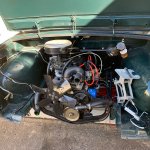Any ideas out there?
I have some prerequisites.
The standard points and ignition coil must be retained and the module triggered off that.
In case of the module failing (which happens) a simple wiring re-connection reverts to points.
The original dizzy runs a cable drive to the tachometer. Originality counts here.
We are dealing with twin Webers, hot cams and cold spark plugs (R12 Gordini, Alpine etc)
It is a pain in the bum starting without fouling, substituting hot plugs etc so I need a very
healthy spark at all times to overcome all this..
Recent experiences fellas?
I have some prerequisites.
The standard points and ignition coil must be retained and the module triggered off that.
In case of the module failing (which happens) a simple wiring re-connection reverts to points.
The original dizzy runs a cable drive to the tachometer. Originality counts here.
We are dealing with twin Webers, hot cams and cold spark plugs (R12 Gordini, Alpine etc)
It is a pain in the bum starting without fouling, substituting hot plugs etc so I need a very
healthy spark at all times to overcome all this..
Recent experiences fellas?



